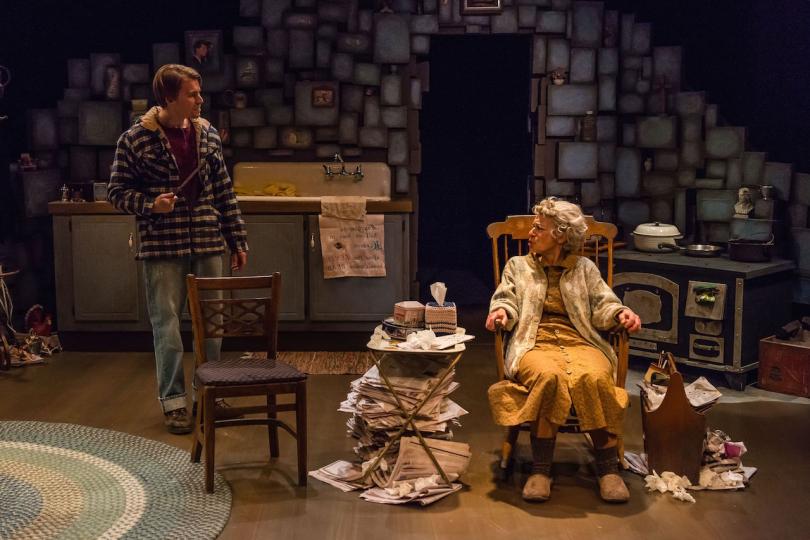A Queen of Mean

There is a popular genre of theater out there that I personally struggle with, but it’s often a hard one for me to identify or avoid in advance. For lack of a better term, I privately like to call this kind of theater the “shitty human being” plays. You know them when you see them: they’re the plays where people are cruel to one another for no particular reason. For instance, Neil LaBute has basically made his career on shitty human being plays. And while there’s something undeniably juicy about watching the dregs of humanity duke it out, and everyone loves a “dark comedy,” I have trouble truly enjoying my time spent in a theater with people who are just plain mean.
That said, of all of the plays out there about terrible human beings, Martin McDonagh’s The Beauty Queen of Leenane is a well-written one, and Theatre Pro Rata has done an excellent job staging it.
The central conflict is between Mag, a housebound 70-year-old hypochondriac, and her middle-aged daughter Maureen, who is Mag’s primary caregiver. The pair has spent years learning exactly how to get under each other’s skin; whatever remnants of tenderness there once were between the two women have long since been corroded by years of demands, obligations, and pure spite.
There is a familiar and enjoyable level of dark humor in their passive-aggressive battles over daily trivia, like the lumps in Mag’s powdered milk drink. But as the play goes on, the outright nastiness becomes tougher to watch: bickering is one thing, but these characters cross the line into outright abuse. Their actions serve the plot and aren’t out of character, but they go ethically and psychologically unexamined to a degree that is a bit hard for me to stomach.
McDonagh’s ear for dialogue
On the other hand, McDonagh has a great ear for dialogue. Beauty Queen, written in 1996, was McDonagh’s first play, and it doesn’t quite nail the rhythm, the zingers, or the thematic unity of his later works like The Pillowman or In Bruges. But the play still has a lot going for it. For one thing, McDonagh is a master at dropping suspenseful breadcrumbs, to the point that I actually heard an audible “oh, shit” coming from the audience early in the second act. He also laces Irish-English political tensions through the script in interesting ways – the play isn’t an overt parable, but it is close enough to elevate the conflict out of the realm of the gratuitous.
McDonagh also writes characters who are well-practiced at manipulation, and Sally Wingert’s and Amber Bjork’s performances of the mother-daughter pair are thrilling to watch, even if the characters aren’t my cup of tea. Wingert has landed perfectly on a balance of physical frailty and mental acuity that imbues Mag with just the right degree of menace, while Bjork portrays Maureen as simmering with tooth-grinding frustration. Their relationship involves some of the most vile, parasitic interactions I have seen on a stage, which makes the play inherently interesting, though not pleasant, to watch. If I could wish for anything in their performances, though, it would be more of a sense of their shared history. I wondered whether there had ever been a shred of affection between the two of them… but there I go again, just wanting people to be nicer to each other.
As Pato and Ray, the brothers who catalyze the action, Grant Henderson and Taylor Evans do an excellent job fleshing out some fairly thinly-written characters. Again, I sometimes couldn’t get behind their motivations, particularly when Ray bluntly and repeatedly tells Mag how annoying it is to be around her. But as Pato, Henderson’s plain-speaking affability was a breath of fresh air, and his likeable performance also helps the audience sympathize with the potential for escape that Pato represents for Maureen.
Smart design choices
As usual, Theatre Pro Rata has made smart design choices that clearly contribute to the viewing experience. First of all, Andrea Heilman’s set adds a wonderful prison-like quality to Mag and Maureen’s small house. The walls are made of a three-dimensional stonework pattern that evokes a dank old jail cell, and rather than just let the living room end ambiguously downstage, Heilman marks off the corners of the room with a low wall. It is largely thanks to the set that Maureen’s sense of claustrophobia, closed off in a small space with her mother with seemingly no end in sight, feels so vividly real.
The lighting design by Julia Carlis is also noteworthy. She has managed to pick a color palette that is somehow both warm and eerie at the same time. There are moments – the flicker of the stove or the shadows cast by a light over Mag’s rocking chair – that are downright threatening, but Carlis’s particular art is in the way she subtly manages to keep us off-balance, always slightly avoiding the balance of light that would make a room feel comfortable and homey.
As I said, I have trouble understanding plays about bad people doing bad things to one another. Unless the play is aiming at more conceptual or satirical targets, characters that are just shitty people feel like a playwriting cop-out to me. They can easily generate dark comedy and deep conflict, but they escape without the moral grey areas that we might see from a more well-rounded character. But McDonagh is a sharp writer, and Theatre Pro Rata does skillful work interpreting his script. The characters may be hateful, but there is still a great deal of satisfaction in watching these skilled artists explore some truly ugly places with such wit, craft, and finesse.




